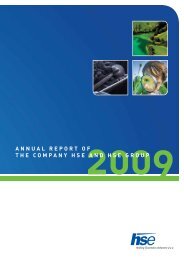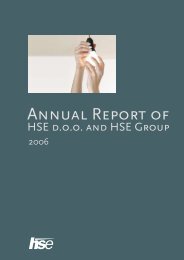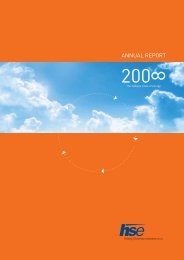Annual report - HSE
Annual report - HSE
Annual report - HSE
Create successful ePaper yourself
Turn your PDF publications into a flip-book with our unique Google optimized e-Paper software.
2.12.2 Operating risks<br />
Market risk<br />
The change in market structure, increasing RES production, constant price fluctuations<br />
of electricity and other primary energy products brought numerous business challenges<br />
as well as control over management of market risks. For the <strong>HSE</strong> Group, a systematic<br />
recording, valuation and risk control is a key element of professional risk management<br />
which must at the same time enable the sizing of new market opportunities.<br />
The risk management policy is based on rules, strategies, decisions and registers adopted<br />
in the period 2008-2012, and has been designed to ensure an increase in the value of <strong>HSE</strong><br />
by assuming risks that fall within the prescribed limits and to enable identification and<br />
exploitation of market opportunities. The risk management process is incorporated in daily<br />
operations of <strong>HSE</strong>.<br />
Based on the adopted market risk management policy, <strong>HSE</strong> monitors exposure of<br />
portfolios (groups of transactions with similar purpose) on the level of individual portfolios<br />
as well as overall exposure of all portfolios, for individual trading years as well as for the<br />
whole trading period.<br />
From the analytical perspective, <strong>HSE</strong> continues with the development of tools for monitoring<br />
influencing factors of market exposures in trade. This predominantly involves monitoring<br />
of price dynamics, volatility and correlations in individual markets in certain periods, and<br />
the company’s position. Parallel to that, improvements and amendments are being made<br />
to the optimisation models and projections of future operation of power plants owned by<br />
the company. In addition, models and mechanisms are being prepared to provide a data<br />
base for new products with which the company may, given the circumstances, trade in the<br />
future.<br />
Market risk associated with market illiquidity<br />
Market risks arising from market illiquidity occur on the markets with lower trading<br />
quantities on the supply or demand side. Such exposure can also arise due to low market<br />
participation of traders or non-conclusion of EFET agreements. The result is inability, or<br />
inappropriate timing, to close a position or closing of a position at unfavourable prices.<br />
In view of operations and risk management of <strong>HSE</strong>, the illiquid wholesale electricity<br />
markets or countries are those where there is no market organiser or electricity exchange.<br />
In 2012, risks were managed with the following activities and methods:<br />
• Segmentation and prioritisation of markets and partners;<br />
• Design of a margin policy in relation to market liquidity and market conditions;<br />
• Promotion of long-term relations with partners;<br />
• Conclusion of contracts with adequate maturity and sufficient contractual safeguards;<br />
• Daily analysis of the company’s position, trading quantities and product prices in illiquid<br />
markets, and of the coverage used for price fluctuations for transactions aimed at<br />
generating added value or minimising the risk of losses in accordance with the principle<br />
of good management;<br />
• Limitation of trade or open position of the company <strong>HSE</strong> in illiquid markets;<br />
• Trading with instruments for hedging against price risks;<br />
• Conclusion of EFET agreements.<br />
Market risk associated with non-transparency of the market<br />
<strong>Annual</strong> Report <strong>HSE</strong> 2012<br />
2 Business Report<br />
84<br />
Market risks associated with non-transparency arise from the markets that can be<br />
characterised by conclusion of transactions at unfavourable prices, incorrect valuation<br />
of price curves and, subsequently, incorrect valuation of the <strong>HSE</strong>’s portfolio. In view of<br />
operations and risk management of the company <strong>HSE</strong>, the non-transparent wholesale<br />
electricity markets are identical to illiquid markets.
















